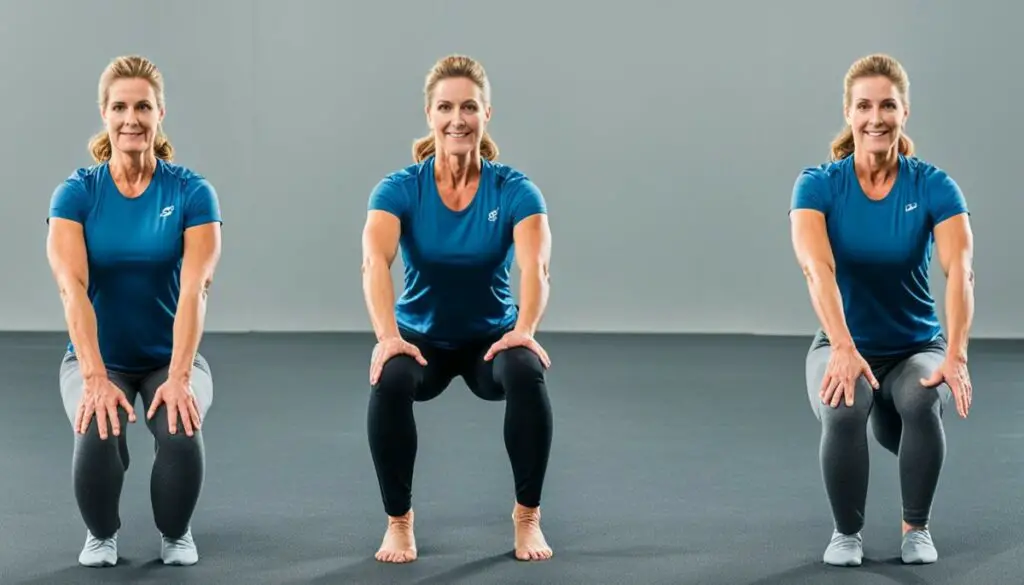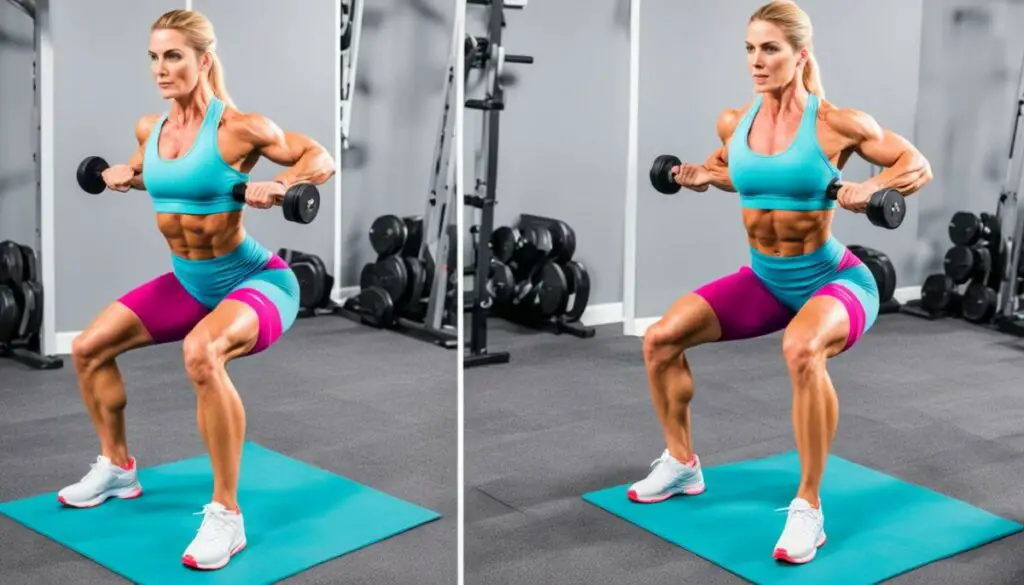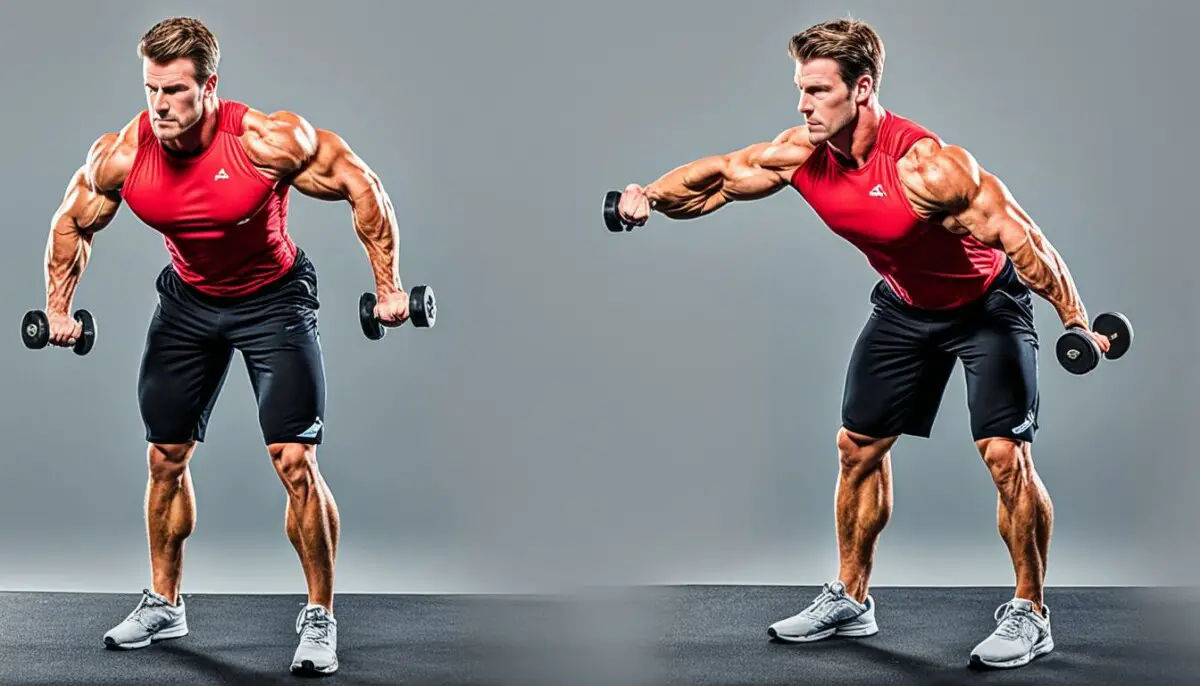Last Updated on 3 months by Francis
The sissy squat is a challenging bodyweight exercise that targets the muscles in your legs, particularly the quadriceps. Despite its name, it is not a “sissy” exercise and can be a valuable addition to your leg workout routine. It helps to build strength and muscle in the quads, and it also engages other muscles such as the rectus femoris and core. By leaning back and keeping the weight shifted forward, you can maximize the activation of your quads during sissy squats.
Contents
Key Takeaways:
- The sissy squat is a challenging bodyweight exercise that targets the quadriceps muscles in the legs.
- It helps build strength and muscle in the quads, as well as engaging other supporting muscles.
- Contrary to its name, the sissy squat is a demanding exercise that requires proper form and technique.
- By leaning back and keeping the weight shifted forward, you can maximize the activation of your quads during sissy squats.
- Incorporating sissy squats into your leg workout routine can lead to increased muscle growth and overall fitness.
How to Do the Sissy Squat

To perform a sissy squat, follow these step-by-step instructions:
- Start by standing upright with your feet hip-width apart.
- Initiate the movement by bending your knees and leaning backward, while keeping your heels off the ground.
- Use your arms to help stabilize yourself and maintain balance throughout the exercise.
- Descend as low as you can while keeping your knees in line with your toes.
- Pause for a moment at the bottom position, maintaining tension in your leg muscles.
- Stand back up by contracting your quads and pushing through your heels.
It’s important to focus on maintaining proper form and engaging your leg muscles throughout the movement to maximize muscle activation. Keep your torso straight, with a slight backward lean, to target the quadriceps effectively. Ensure your knees stay in line with your toes, and avoid letting them cave inward or move too far forward. Remember to perform the exercise in a controlled manner, inhaling during the descent and exhaling as you stand back up.
Sissy Squat Variations

Adding variations to your sissy squat routine can target different muscles and provide a fresh challenge to your workout. Here are three popular sissy squat variations for muscle development:
Band-Assisted Sissy Squat
If you struggle with balance or stability during the sissy squat, the band-assisted variation is perfect for you. With a resistance band secured around a stable object or wrapped around your shoulders, you can maintain better control throughout the movement and focus on engaging your quads. The resistance band also helps to gradually build strength and increase stability over time.
Weighted Sissy Squat
If you’ve mastered the bodyweight sissy squat and want to intensify your workout, try the weighted sissy squat. Holding a weight, such as a dumbbell or kettlebell, adds resistance and increases the challenge on your quads. Alternatively, you can wear a weighted vest for a more evenly distributed load. Start with a lighter weight and gradually increase as you become more comfortable.
Kneeling Sissy Squat
The kneeling sissy squat is a variation that focuses on the lower portion of the range of motion, particularly targeting the quad muscles. Start in a kneeling position with your feet secured under a stable object or anchored. Lean backward and perform the squatting motion with a controlled descent until your thighs are parallel to the ground. This variation can be especially effective for quad development and enhancing overall lower body strength.
By incorporating these sissy squat variations into your routine, you can target specific muscles, add variety to your workout, and achieve progressive overload for muscle development.
Common Sissy Squat Mistakes
When performing sissy squats, it’s important to be aware of common mistakes that can hinder your progress and increase the risk of injury. By understanding and avoiding these mistakes, you can optimize your sissy squat technique and maximize muscle activation in your legs.
Here are some common sissy squat mistakes to watch out for:
1. Not Bracing Your Torso
One of the most common mistakes in sissy squats is neglecting to brace your torso. Failure to engage your core and maintain a stable upper body can lead to poor form and reduced effectiveness of the exercise. To avoid this, focus on keeping your abdominals tight and maintaining a neutral spine throughout the movement. This will help stabilize your entire body and ensure proper muscle activation in your legs.
2. Inhibiting Knee Travel
Another mistake to avoid is inhibiting knee travel during sissy squats. Proper knee tracking is essential for engaging the quadriceps effectively. Allow your knees to move forward naturally, in line with your toes, as you descend into the squat. Restricting the movement of your knees can shift the load away from the desired muscle group and compromise the effectiveness of the exercise.
3. Leaning Too Far Back
Leaning too far back is a common error that can throw off your balance and compromise proper muscle engagement. While it is important to lean back slightly during a sissy squat to emphasize quad activation, excessive backward lean can shift the focus away from the quads and onto other muscles. Maintain a controlled lean, keeping your weight shifted forward, to optimize quadriceps recruitment.
“Proper form and technique are essential in sissy squats to ensure optimal muscle activation and prevent injuries.”
By being mindful of these common mistakes and focusing on maintaining proper form throughout your sissy squat exercises, you can maximize the benefits and minimize the risk of injury. Pay attention to your technique, engage your core, allow proper knee travel, and avoid excessive backward lean to optimize muscle activation and achieve the best results from your sissy squat workouts.
Who Should Do the Sissy Squat

The sissy squat is a versatile exercise that can benefit a wide range of individuals. It is particularly effective for targeting and strengthening the quadriceps, making it ideal for those who want to prioritize leg muscle development. However, it’s important to be mindful of certain considerations when incorporating the sissy squat into your workout routine.
Individuals with knee pain or limited range of motion should exercise caution and consult a healthcare professional before attempting the sissy squat. This exercise places significant stress on the knee joints, and proper form is crucial to avoid exacerbating any existing issues. A healthcare professional can provide guidance on modifications or alternatives that are better suited to your specific needs.
Furthermore, the sissy squat can also engage the glute muscles isometrically, making it an exercise of interest for those looking to activate their glutes. By maintaining tension in the glute muscles throughout the movement, individuals can experience additional benefits beyond quadriceps activation.
Overall, the sissy squat can be incorporated into leg workouts for individuals of various fitness levels. However, it is imperative to prioritize appropriate form and technique to prevent injury. Beginners should start with bodyweight squats and gradually progress to more advanced variations, while advanced individuals can explore weighted or band-assisted sissy squats to increase intensity.
Remember to listen to your body, consult a professional when needed, and prioritize safety to reap the full benefits of sissy squats.
| Level of Fitness | Recommended Approach |
|---|---|
| Beginner | Start with bodyweight squats and focus on proper form. Gradually increase depth and intensity as strength and control improve. |
| Intermediate | Introduce variations like elevated heel squats, band-assisted squats, or using light weights for added resistance. |
| Advanced | Engage in weighted sissy squats, single-leg squats, or explore different squat machine variations to continuously challenge and evolve your leg workout. |
Benefits of the Sissy Squat

The sissy squat is a highly effective exercise that offers numerous benefits for individuals who incorporate it into their leg workout routine. By regularly performing sissy squats with proper form and technique, you can expect to see improvements in lower body strength, muscle definition, and overall fitness level.
This exercise primarily targets and strengthens the quadriceps, leading to increased muscle growth and strength in the legs. The quadriceps, also known as the “quads,” are the large muscles located in the front of the thighs. By engaging and working these muscles through sissy squats, you can develop stronger and more defined quads.
Additionally, the sissy squat also activates the glutes isometrically, meaning it engages the glute muscles without actually going through a full range of motion. This can provide some benefits for glute activation, making it a suitable exercise for individuals looking to target their glutes.
Not only does the sissy squat help develop muscle strength, but it also contributes to improved muscle endurance. Performing this exercise requires control and stability, which can enhance your overall physical fitness.
Furthermore, the sissy squat is a convenient and efficient exercise that can be performed without the need for additional equipment. It can be incorporated into your leg workout routine or used as a standalone exercise to target the quads and activate the glutes.
“The sissy squat is an effective exercise for targeting and developing the quadriceps and can help you achieve stronger, more defined legs.” – Fitness Expert
Incorporating sissy squats into your fitness regimen can yield significant results in terms of lower body strength, muscle definition, and overall fitness level. Remember to always prioritize proper form and technique to maximize the benefits of this exercise.
| Benefits of the Sissy Squat | Description |
|---|---|
| Targeted Quadriceps Development | The sissy squat primarily targets the quadriceps, leading to increased muscle growth and strength in the legs. |
| Glute Activation | The sissy squat can also activate the glutes isometrically, providing benefits for glute activation. |
| Muscle Endurance | The sissy squat requires control and stability, contributing to improved muscle endurance. |
| Convenience and Efficiency | The sissy squat can be performed without the need for additional equipment and can be easily incorporated into your workout routine. |
By incorporating sissy squats into your leg workout routine and maintaining consistency, you can expect to see noticeable improvements in your lower body strength, muscle definition, and overall fitness. Remember to start with proper form and progress gradually to avoid injury and maximize your results.
How to Progress in Sissy Squats
To continue challenging your muscles and make progress in sissy squats, there are several effective strategies you can implement. By gradually increasing the difficulty and intensity of your workouts, you can push your limits and see continued improvements in quad strength and muscle development.
Assisted Sissy Squats: Start your progression by performing assisted sissy squats. This can be done by using a support structure, such as a pole or wall, to help maintain stability and balance. Alternatively, you can have a partner assist you by holding your hands or providing support as you descend into the squat. Assisted sissy squats allow you to focus on proper form and engage the quads without worrying too much about stability.
Decrease Assistance or Increase Range of Motion: As you become more comfortable with assisted sissy squats, gradually decrease the assistance or increase the range of motion. For example, if you were using a support structure, try performing the squats without it and rely more on your own stability. You can also aim to descend lower into the squat, making sure to maintain proper form and control throughout the movement.
Elevate Heels: Elevating your heels during sissy squats can provide a deeper range of motion and increase the challenge for your quads. You can achieve this by placing a small weight plate or wedge under your heels before performing the squat. This modification targets the quads from a different angle and can help stimulate muscle growth.
Weighted Sissy Squats: Once you’ve mastered bodyweight sissy squats, you can add resistance to further progress the exercise. Hold a weight, such as a dumbbell or kettlebell, in front of your chest while performing the squat. This added resistance increases the demand on your quads and promotes further muscle development. Alternatively, you can wear a weighted vest to increase the intensity of the exercise.
Band-Assisted Sissy Squat: Another way to progress in sissy squats is by incorporating band-assistance. Attach a resistance band to a stable anchor point, such as a pole or a squat rack, and loop it around your shoulders. This band will provide additional support and assistance as you perform the squat, allowing you to maintain stability while still challenging your quads.
“Progress in sissy squats by gradually increasing difficulty and intensity, such as decreasing assistance, increasing range of motion, elevating heels, adding resistance, or using band-assistance.”
Implementing these strategies into your sissy squat routine will ensure that you continue challenging your muscles and making progress. Remember to listen to your body and progress at a pace that feels comfortable for you. With consistency and determination, you’ll see improvements in your quad strength and overall fitness level.
| Progression Strategy | Description |
|---|---|
| Assisted Sissy Squats | Use a support structure or assistance from a partner to maintain stability and balance. |
| Decrease Assistance or Increase Range of Motion | Gradually decrease assistance or increase the depth of the squat to challenge your quads. |
| Elevate Heels | Place a weight plate or wedge under your heels to increase the difficulty and range of motion. |
| Weighted Sissy Squats | Hold a weight in front of your chest while performing the squat to add resistance. |
| Band-Assisted Sissy Squat | Attach a resistance band for support and assistance during the squat. |
Other Exercises for Quadriceps Development
While sissy squats can be an effective exercise for targeting and developing the quadriceps, there are other exercises that can provide similar benefits. Incorporating a variety of exercises into your leg workout routine can help you achieve well-rounded quadriceps development and maximize your muscle growth and strength.
1. Spanish Squats
Spanish squats, also known as heel-elevated squats, are a great alternative to sissy squats that specifically target the quadriceps. This exercise involves elevating your heels with a wedge or weight plate, allowing for greater range of motion and increased activation of the quads. The mechanics of Spanish squats are similar to traditional squats, but the elevated heels shift the focus onto the quadriceps muscles.
2. Cyclist Squats
Cyclist squats, also referred to as split squats or Bulgarian split squats, are another effective exercise for developing the quadriceps. This exercise involves stepping one foot forward and placing the other foot back on an elevated surface, such as a bench or step. As you lower into the squat position, the majority of the weight is placed on the front leg, placing significant emphasis on the quadriceps muscles. Cyclist squats offer unilateral training, which can help correct muscle imbalances and improve overall leg strength.
3. Pistol Squats
Pistol squats, also known as single-leg squats, require balance, stability, and lower body strength. This exercise involves squatting down on one leg while keeping the opposite leg extended in front of you. Pistol squats heavily engage the quadriceps, as well as the glutes and hamstrings, due to the increased demands of balancing and stabilizing. Progressing to pistol squats can be challenging, but it is a rewarding exercise for building strength and enhancing quadriceps development.
By incorporating these exercises into your leg workout routine, you can target and develop your quadriceps muscles while adding variety and increasing the challenge. Remember to focus on maintaining proper form and engaging the targeted muscles throughout each exercise for optimal results.
| Exercise | Main Muscles Targeted |
|---|---|
| Spanish Squats | Quadriceps |
| Cyclist Squats | Quadriceps |
| Pistol Squats | Quadriceps, Glutes, Hamstrings |
The Science Behind Muscles Worked by the Sissy Squat
When it comes to targeting and activating specific muscles, the sissy squat is a standout exercise. Primarily focusing on the quadriceps, specifically the rectus femoris muscle, the sissy squat engages multiple muscle groups to deliver effective results.
The rectus femoris is one of the four compartments that make up the quadriceps and crosses both the hip and knee joints. During the sissy squat, this muscle is stretched and activated in a unique way. The exercise involves knee flexion and extension with the hips in a locked position, which maximizes the activation of the rectus femoris.
In addition to the rectus femoris, other muscles are engaged during the sissy squat, including the core muscles. These core muscles play a crucial role in providing stability and maintaining proper form throughout the exercise. By engaging both the rectus femoris and core muscles, the sissy squat offers a comprehensive workout for the lower body.
The Origin and Name of the Sissy Squat
The sissy squat gets its name from the Greek mythology figure Sisyphus, who was punished by the gods and forced to push a boulder up a hill repeatedly. Sisyphus developed strong quadriceps from this punishment, and the sissy squat exercise mimics the movement of pushing a boulder uphill, emphasizing quadriceps activation. The name “sissy” is ironic, as the exercise is anything but easy or weak. It pays homage to the legend of Sisyphus and the strength it took to endure his punishment.
Tips to Improve Your Sissy Squats
If you want to optimize your sissy squat performance and maximize muscle activation, try incorporating these helpful tips:
- Focus on proper form: Maintaining proper form is crucial for optimal muscle engagement during sissy squats. Keep your knees aligned with your toes, lean back as you descend, and contract your quads to stand back up. This ensures that your quadriceps are the primary muscles targeted.
- Engage your core: Activating your core muscles provides stability and helps maintain balance throughout the exercise. Keep your core engaged throughout the movement to enhance overall strength and control.
- Control your descent: Slowly lower yourself down during the squat to fully engage your quadriceps and increase time under tension. Avoid quick or jerky movements that may compromise muscle activation.
- Experiment with foot placement: Adjusting the position of your feet can alter muscle activation during the sissy squat. Try placing your feet closer or wider apart to target different areas of your quadriceps.
- Execute the exercise mindfully: Pay attention to your body and the muscle groups you are targeting. Visualize the contraction of your quadriceps with each repetition to establish a stronger mind-muscle connection.
- Incorporate progressive overload: As your strength improves, consider adding resistance to your sissy squats. You can use dumbbells, resistance bands, or a weighted vest to increase the challenge and continue stimulating muscle growth. Gradually increase the resistance over time to promote progression.
Remember, consistency and patience are key when it comes to seeing progress in your sissy squat performance. By implementing these tips and focusing on proper technique, you can enhance your muscle activation, build strength, and achieve your fitness goals.
| Tips to Improve Your Sissy Squats | Benefits |
|---|---|
| Focus on proper form | Ensures optimal muscle engagement |
| Engage your core | Enhances stability and overall strength |
| Control your descent | Increases time under tension for greater muscle activation |
| Experiment with foot placement | Targets different areas of the quadriceps |
| Execute the exercise mindfully | Establishes a stronger mind-muscle connection |
| Incorporate progressive overload | Promotes muscle growth and continued progression |
Conclusion
The sissy squat is an incredibly effective exercise for targeting and developing the quadriceps. By incorporating this challenging bodyweight exercise into your leg workout routine, you can experience a wide range of benefits that will enhance your overall fitness level.
Performing sissy squats with proper form and technique allows you to activate and engage not only your quadriceps muscles but also other supporting muscles such as the rectus femoris and core. This comprehensive engagement leads to increased leg strength, muscle growth, and improved overall muscular endurance.
To maximize the benefits of sissy squats, it is essential to progress gradually and incorporate variations into your training. By gradually increasing resistance or range of motion, you can continue challenging your muscles and promoting further growth and strength development.
Remember, before adding sissy squats to your workout routine, it is important to prioritize warm-up exercises and mobility work to prevent injury and ensure optimal performance. If you have any pre-existing conditions or concerns, it is always wise to consult with a healthcare professional or fitness expert.
FAQ
What muscles does the sissy squat work?
The sissy squat primarily targets the quadriceps, specifically the rectus femoris muscle. It also engages other muscles such as the core muscles for stability and proper form.
How do you perform a sissy squat?
To perform a sissy squat, start by standing upright with your feet hip-width apart. Bend your knees and lean backward, while keeping your heels off the ground. Descend as low as you can while maintaining balance and then contract your quads to stand back up.
What are some variations of the sissy squat?
Some variations of the sissy squat include the band-assisted sissy squat, weighted sissy squat, and kneeling sissy squat. These variations provide different levels of muscle engagement and can target specific muscle groups.
What are common mistakes to avoid when doing sissy squats?
Common mistakes to avoid during sissy squats include not bracing your torso, inhibiting knee travel, and leaning too far back. Maintaining proper form is crucial for maximizing muscle activation and minimizing the risk of injury.
Who should do the sissy squat?
The sissy squat can be beneficial for individuals looking to target and strengthen their quadriceps. It can also engage the glute muscles isometrically, making it suitable for those looking to activate their glutes. However, individuals with knee pain or limited range of motion should proceed with caution and consult a healthcare professional.
What are the benefits of the sissy squat?
The sissy squat can improve lower body strength, muscle definition, and overall fitness level. It targets the quadriceps and can also engage the glutes isometrically. Regularly performing sissy squats with proper form can lead to muscle growth and increased strength in the legs.
How can I progress in sissy squats?
To progress in sissy squats, you can start with assisted sissy squats and gradually decrease assistance or increase range of motion. Elevating your heels and adding resistance through weighted sissy squats or variations can also enhance the challenge and target different muscle groups.
What are some other exercises for quadriceps development?
Spanish squats, cyclist squats, and pistol squats are examples of exercises that can also target the quadriceps and contribute to leg strength and muscle growth. Incorporating a combination of these exercises can offer a well-rounded approach to quadriceps development.
How does the sissy squat activate muscles?
The sissy squat activates the quadriceps, particularly the rectus femoris, due to the specific mechanics of the exercise. It involves knee flexion and extension with the hips locked in position. Other muscles, such as the core muscles, are engaged for stability and proper form.
Why is it called a sissy squat?
The sissy squat gets its name from the Greek mythology figure Sisyphus, who was punished by the gods and forced to push a boulder up a hill repeatedly. Sissy squats mimic the movement of pushing a boulder uphill, emphasizing quadriceps activation. The name “sissy” is ironic, as the exercise is challenging and requires strength.
How can I improve my sissy squat performance?
To improve your sissy squat performance, you can focus on maintaining proper form, gradually increasing resistance or range of motion, and incorporating proper warm-up and mobility exercises. These strategies can help maximize muscle activation and prevent injury.









